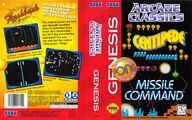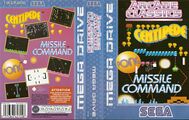Arcade Classics
From Sega Retro
| Arcade Classics | |||||
|---|---|---|---|---|---|
| System(s): Sega Mega Drive, Sega Game Gear | |||||
| Publisher: Sega | |||||
| Developer: Atari, Al Baker & Associates | |||||
| Game total: 3 | |||||
| Sound driver: GEMS | |||||
| Genre: Compilation | |||||
| Number of players: 1-2 | |||||
| |||||
Arcade Classics is a compilation of three arcade games originally released by Atari during the 1970s and early 1980s. The compilation was released for the Sega Mega Drive and Sega Game Gear in 1996.
As well as providing "classic" versions of the games, there are also enhanced "Sega" versions, which update the graphics. Sadly the games are plagued by framerate issues, slowing down considerably when numerous objects are on screen.
Contents
Development
Sega wanted three Atari classics converted to the Mega Drive with as much integrity as possible. Therefore, the games used in the compilation were based directly off Atari code. The Atari 7800 version of Centipede and Atari 2600 version of Missile Command were converted from the original 6502 assembly language code to the Z80 for the Game Gear version and then from Z80 to the 68000 for the Mega Drive.
While all the code specifically associated with sound and graphics had to be re-written, the initial conversions were done using the developer's own 6502 to Z80 and Z80 to 68000 assembly language converters. Pong, a hard-wired console game which was reverse engineered for the Game Gear, was initially converted from the Game Gear to the Mega Drive using a Z80 to 68000 assembly language converter. The video and sound modules were then rewritten to complete the process.
Gameplay
Centipede
This is a recreation of the original Centipede. The player controls a spaceship who must destroy a centipede made up of several ball-shaped pieces crawling down from the top of the screen. The player can move freely with the directional pad, however is restricted to the bottom of the screen. ![]() and
and ![]() shoot and can be held down for rapidfire. Every time one piece of the centipede is destroyed, the centipede is broken at the destroyed piece, with each new piece moving independently. If hit by either a centipede or a spider which also comes up occasionally, a life is lost and the centipede reforms. The spider can be destroyed for bonus points. Mushroom barricades are scattered around the field; if they are shot, they become weaker and weaker until they are destroyed. If the centipedes reach the bottom of the screen, they will start climbing back up.
shoot and can be held down for rapidfire. Every time one piece of the centipede is destroyed, the centipede is broken at the destroyed piece, with each new piece moving independently. If hit by either a centipede or a spider which also comes up occasionally, a life is lost and the centipede reforms. The spider can be destroyed for bonus points. Mushroom barricades are scattered around the field; if they are shot, they become weaker and weaker until they are destroyed. If the centipedes reach the bottom of the screen, they will start climbing back up.
The Sega version features new graphics.
Ultrapong
This has either Pong or Hockey to be chosen from. The goal of both is simple: the player, capable of moving vertically from edge to edge, must hit the ball through the other player's goal and stop the ball from going through theirs; first to 15 wins. In Pong, the goal is the edge of the screen. In Hockey, the goal is the inside of a smaller shape resembling a hockey goal (the ball will bounce around a goal if it is shot toward the top or bottom edge of the screen). Game "Styles" merely control the number of paddles in use. Barriers can also be placed for added difficulty.
The Sega version features different sound effects for when the ball hits a paddle.
Missile Command
This is a recreation of the original Missile Command. The player controls a missile turret fixed to the bottom center of the screen. Use the D-pad to move the target crosshairs and ![]() or
or ![]() to shoot. There are two types of enemies: aliens which fly horizontally through the screen and can be destroyed normally or missed with no consequence to the player, or slowly falling ropes that must be destroyed at their tips before they hit the ground; should one hit the ground, a life will be deducted.
to shoot. There are two types of enemies: aliens which fly horizontally through the screen and can be destroyed normally or missed with no consequence to the player, or slowly falling ropes that must be destroyed at their tips before they hit the ground; should one hit the ground, a life will be deducted.
The Sega version features new graphics and a different title screen theme (the other games simply keep playing the main menu music).
Credits
1
| <html>
<head><title>301 Moved Permanently</title></head> <body> 301 Moved Permanently</body> </html> Mega Drive version
|
Game Gear version |
|---|---|
| |
Physical Scans
Mega Drive Version
| Sega Retro Average | ||||||||||||||||||||||||||||||||||||||||||||
|---|---|---|---|---|---|---|---|---|---|---|---|---|---|---|---|---|---|---|---|---|---|---|---|---|---|---|---|---|---|---|---|---|---|---|---|---|---|---|---|---|---|---|---|---|
|
| 38 | |
|---|---|
| Based on 8 reviews | |
Game Gear Version
- ↑ 1700 igr dlya Sega, "" (RU; 2001-xx-xx), page 37
- ↑ Electronic Gaming Monthly, "July 1996" (US; 1996-xx-xx), page 22
- ↑ Game Players, "Vol. 9 No. 7 July 1996" (US; 1996-06-11), page 58
- ↑ GamePro, "August 1996" (US; 1996-xx-xx), page 70
- ↑ Mega Fun, "11/96" (DE; 1996-10-16), page 54
- ↑ Next Generation, "September 1996" (US; 1996-08-20), page 162
- ↑ Player One, "Septembre 1996" (FR; 1996-08-29), page 122
- ↑ VideoGames, "August 1996" (US; 1996-07-xx), page 65




